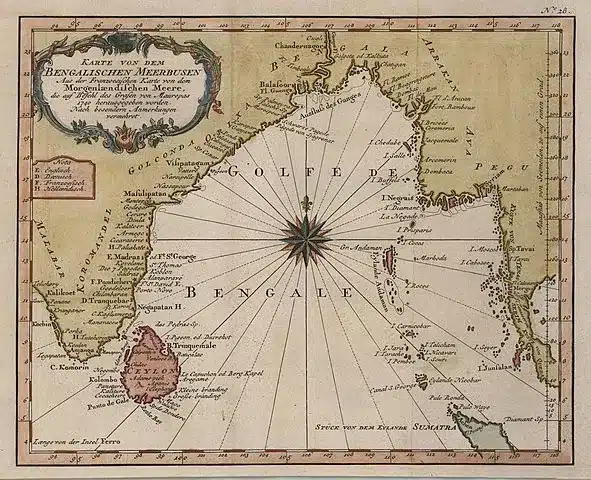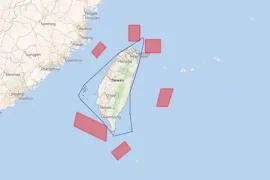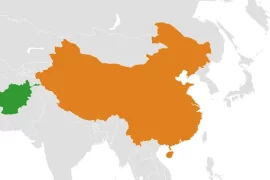The Bay of Bengal, seemingly placid with seasonal cyclones, holds a fascinating history of trade, cultural exchange, and geopolitical rivalries. Bordered by important countries like Burma, Bangladesh, and India—the Bay of Bengal’s geopolitical importance is undergoing a resurgence. Once considered a closed sea, it is now becoming a zone of contention among major powers. This article delves into the rich history of the Bay of Bengal, tracing its evolution from a natural bridge between ancient civilizations to a focal point of geopolitical rivalry in the emerging Indo-Pacific region.
Ancient Maritime Bridges
In antiquity, the Bay of Bengal acted as a vital conduit between the Indian subcontinent and regions stretching eastward, including China’s southern coast. It was the maritime highway between India and China. The movement of people, goods, and ideas thrived along its littoral, enriching the civilizations that flourished there. The spread of Hinduism, Buddhism, and Islam was facilitated by the bustling trade between coastal communities.
As European powers arrived, vying for resources and markets, the Bay became a hotspot of competition leading to the colonization of territories surrounding its shores. First came the Portuguese, followed by the Dutch, British, and French.
The British Raj Dominance
By the early 19th century, Great Britain emerged triumphant in European rivalries. It established its primacy in the Bay of Bengal region. Under the British Raj, the Subcontinent underwent political integration, extending its control over Burma and the Malay Peninsula. The entire Bay of Bengal littoral, spanning from Ceylon to Singapore, fell under the Raj’s hegemony, allowing for strategic direction of the region’s resources and economic integration into global trade networks. In the early 20th century, the Bay of Bengal became one of the most vibrant economic zones in the world.
Seeking commodities like coffee, rice, and rubber, the British established plantations in Malaysia and Sri Lanka. To meet the growing demand for labor, millions of Indian migrants embarked on one of the largest migrations in modern history. They crossed the sea to work on these plantations as well as in the docks and factories of Burma. The impact of this mass migration was profound, transforming bustling port cities like Singapore and Penang into highly culturally diverse societies.

Challenges and Shifting Tides
The British Raj’s dominance faced challenges during the First and Second World Wars. The Japanese threat during the latter conflict revealed vulnerabilities in the region’s security and led to the eventual decline of British influence. The post-war era witnessed decolonization, reshaping the geopolitical landscape and eroding the Bay’s strategic significance.
The Bay of Bengal’s Resurgence
In the new millennium, the Bay of Bengal is once again emerging as a critical geopolitical arena. As the global balance of power shifts, major players are turning their attention to the Bay’s potential. China’s rise as a global power has led to increased economic interests and influence projection in the region. The historically dominant India is also seeking to safeguard its strategic interests and establish partnerships with littoral nations.
With the involvement of major powers, the Bay of Bengal is witnessing the resurgence of geopolitical rivalries. The United States and Japan are closely monitoring developments in the region. They want to implement their agenda of a free and open Indo-Pacific, while regional players seek to balance their interests.
The Bay of Bengal’s history also demonstrates the transformative power of trade and cultural exchange. To maintain regional stability and foster prosperity, littoral nations must focus on cooperation and dialogue. Addressing environmental challenges, promoting sustainable development, and ensuring a rules-based order will be critical in navigating the region’s future.
Summary of the history of the Bay of Bengal
In conclusion, the Bay of Bengal’s enchanting history highlights its enduring significance. From ancient maritime connections to modern great-power rivalries, this water body continues to shape the destinies of the nations along its shores. As the world watches its evolving geopolitical landscape, the Bay’s littoral nations must tread carefully to harness its potential for peace, cooperation, and shared prosperity in the dynamic Indo-Pacific region.
History of the Bay of Bengal: FAQs
Q. Why is it called the Bay of Bengal?
A: The Bay of Bengal is named due to its geographical location and historical significance. Geographically, it lies in the northeastern part of the Indian Ocean, bordered by India and Bangladesh to the west and north, and the Southeast Asian mainland to the east, with India and Sri Lanka forming its southern boundary. The term “Bay” denotes a large body of water partially enclosed by land. Historically, it was associated with the region of Bengal (now encompassing Bangladesh and West Bengal in India). For instance, in Sanskrit, it was referred to as “Bangopasaagara.” The name “Bay of Bengal” gained international recognition during the British colonial period, solidifying its current name.
Q. What is the largest bay in the world?
A: The Bay of Bengal, covering an expansive area of approximately 839,000 square miles (2,173,000 square km), is the largest bay in the world. Situated in the northeastern region of the Indian Ocean, it commands a prominent geographical location.







